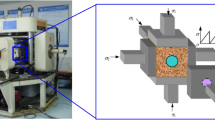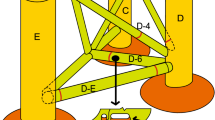Abstract
The determination of the point of failure during an accident sequence of a rear leaf spring in a sport utility vehicle is presented in terms of fracture surface analysis and residual-strength estimates. Marks at the scene of the accident pointed to two possibilities for the point of failure: marks in the roadway at the start of the accident sequence and a rock strike near the end of the sequence. Evidence from rust and chemical contamination on the fracture pointed to the spring having been cracked in half prior to the accident. Extensive woody fracture and secondary cracking at the midplane of the spring was evidence for segregation and weakness in the spring. Stress estimates for the effect of both the weakness and prior cracking on the residual strength of the spring revealed reductions in strength of the spring that could produce fracture at the start of the accident sequence. The point of failure of the spring was placed at the start of the accident sequence.
Similar content being viewed by others
References
J. Goldstein et al.: Scanning Electron Microscopy and X-Ray Analysis, 3rd ed., Kluwer Academic/Plenum, New York, NY, 2003, pp. 476–79.
A.J. Tetelman and A.J. McEvily: Fracture of Structural Materials, John Wiley, New York, NY, 1967, pp. 105–07.
R.W. Hertzberg: Deformation and Fracture Mechanics of Engineering Materials, 3rd ed., John Wiley, New York, NY, 1983, pp. 258–59.
H.E. McGannon, ed.: The Making, Shaping, and Treating of Steel, 8th ed., U.S. Steel, Pittsburgh, PA, 1964, pp. 355–56.
C.L. Briant and S.K. Banerji: “Intergranular Failure in Steel: The Role of Grain Boundary Composition,” Int. Met. Rev., 1978, 23(4), pp. 164–99.
D.A. Moore, K.F. Packer, A.J. Jones, and D.M. Carlson: “Crankshaft Failure and Why It May Happen Again,” Prac. Fail. Anal., 2001, 1(3), pp. 63–72.
Fractography and Atlas of Fractographs, vol. 9, Metals Handbook, 8th ed., American Society for Metals, Metals Park, OH, 1974, pp. 29–30.
J.C.M. Farrar and R.E. Dolby: “Lamellar Tearing in Welded Steel Fabrication, The Role of Sulfide Inclusions,” Sulfide Inclusions in Steels, J.J. de Barbadillo and E. Snape, ed., American Society for Metals, Metals Park, OH, 1975, pp. 252–68.
A.J. DeArdo and E.G. Hamburg: “Influence of Elongated Inclusions on the Mechanical Properties of High Strength Steel Plate,” Sulfide Inclusions in Steels, J.J. de Barbadillo and E. Snape, ed., American Society for Metals, Metals Park, OH, 1975, pp. 309–37.
Manual on Design and Application of Leaf Springs, SAE HS 788, Society of Automotive Engineers, Warrendale, PA, April 1980.
R.W. Hertzberg: Deformation and Fracture Mechanics of Engineering Materials, 3rd ed., John Wiley, New York, NY, 1983, p. 411.
Fatigue and Fracture, vol. 19, ASM Handbook, ASM International, Materials Park, OH, 1996, pp. 622, 625.
Author information
Authors and Affiliations
Rights and permissions
About this article
Cite this article
Clarke, C.K., Borowski, G.E. Evaluation of a leaf spring failure. J Fail. Anal. and Preven. 5, 54–63 (2005). https://doi.org/10.1361/154770205X76303
Received:
Revised:
Issue Date:
DOI: https://doi.org/10.1361/154770205X76303




